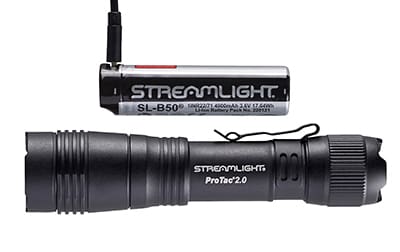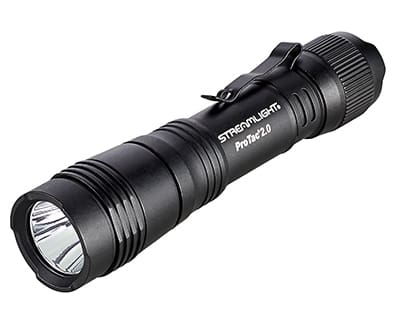
From Streamlight . . .
Streamlight Inc., a leading provider of high-performance lighting and weapon light/laser sighting devices, launched the 2,000-lumen ProTac 2.0, a high-performance rechargeable handheld tactical light, offering extreme brightness and long run times. The rechargeable light is powered by the new Streamlight SL-B50 battery pack that charges directly via an integrated USB-C port.
“This latest addition to the ProTac series of tactical handheld lights gives first responders, outdoor enthusiasts, technicians and other users an ideal light for everyday use that provides ultra-bright light while not sacrificing run times,” said Streamlight Chief Revenue Officer Michael F. Dineen. “They also will appreciate the convenience and ease of charging the new SL-B50 battery pack either inside or outside of the light, via a USB-C charge cord.”
The ProTac 2.0 uses the SL-B50 proprietary Streamlight 4,900mAh protected Lithium-Ion USB rechargeable battery, accessed by the light’s sliding sleeve. The battery is keyed to ensure proper alignment of the charging port, and features LED status lights to indicate charging status, including red for charging and green for fully charged. An integrated safety circuit protects the battery from accidental overcharge or discharge.

The new light offers the latest in power LED technology for extreme brightness and provides three operating modes – High, Medium and Low. On High, it delivers 2,000 lumens and 17,300 candela; on the Medium setting, it provides 570 lumens and 5,000 candela and on Low, it offers 100 lumens and 890 candela. Run times range from 25 hours on Low to 2.5 hours on High. The light’s strobe features a 4-hour and 25-minute run time.
The ProTac 2.0 uses a TEN-TAP® programmable switch, which allows for user selection from among three programs: high/strobe/low (factory default); high only; or low/medium/high.
Fabricated from 6000 series machined aircraft aluminum with an anodized finish, the ProTac 2.0 also features an anti-roll head and a gasket-sealed lens. Its multi-function, push-button tactical tail switch permits one-handed operation of the momentary, variable intensity or strobe modes. The light also comes with a removable, multi-position pocket clip, holster and USB-C charge cord.
The ProTac 2.0 is 6.10 inches in length and weighs 8.25 ounces with one included SL-B50 rechargeable battery. The light has an IP67-rated design for dust-tight and waterproof operation to one meter for 30 minutes and is impact resistance-tested to two meters.
Available in black, the ProTac 2.0 has an MSRP of $195.00. It comes with Streamlight’s Limited Lifetime Warranty.
MSRP = $195





Well this is about a week late. I just bought the olight Javelot for my SFAR.
I carry the protac on my truck and house carbines and like them. The rechargeable and higher intensity would be a cool thing especially with just a C connection
I carry an Imalent LD70. It’s smaller, 4000 laments, and one quarter the price.
Requesting a proper review please. Looks good on specs, but tells nothing of important parameters like spot & spill performance.
Preliminary turn offs:
– Proprietary battery pack.
– Type C should be embedded in the housing body instead of attached to the batt pack.
– Tape switch when?
– Dislike multi-function single switches, goes double for tailcap only. Preference for individual switches, minimum constant on and momentary separated. Better still when programming sw. is standalone.
– Vampire?
For any wondering, it’s a 1.02″ o.d. body. Info buried in the fact sheet. Also appears to employ a Joule Thief circuit for maximum optimal battery life interestingly, from this statement.
“Fully regulated output for consistent lumen performance over the entire battery life.”
Its a promotion advertisement, not a review.
Which is why I asked for a proper review in the beginning of the post.
check zeroair.org for reviews.
William,
In my experience, TTAG doesn’t DO “real reviews”. They introduce some interesting products . . . which I immediately go and research somewhere else.
TTAG has its uses, but they are . . . limited, to say the least.
@Lamp
Mostly true. Still find people parroting widely that b.s. Leghorn wrote about Vepr 12’s with his severe hate-boner for anything not AR.
“– Proprietary battery pack. ”
Nope, that’s a common form-factor these days, and for a light, it’s a nice option to have, since you can recharge via a cigarette lighter USB gadget or ‘power bank’…
Keyed index on the battery pack? And the documentation on Streamlight’s site claims it is proprietary.
The ‘keyed index’ is what is on most tubular batteries, the raised ‘button’ of the positive terminal.
Simple, (mostly) foolproof.
Typical advertising whizz-words, trying to make your product look better than the others, when it’s the same damn thing…
Yeah, I don’t see any reason to buy that. The FENIX PD36R PRO is cheaper, brighter, and has the USB-C port on the flashlight.
“USB-C port on the flashlight” which= NO IP rating.
The similar Streamlight B26 battery has been an awesome performer across many light models over the last 15months. GREAT battery at very reasonable price. (If a B26 quits, remove it and drop in 2x 123).
I expect great things from the B50 battery.
For the money we pay for this kind of accessory, I would really like to see something a little more modern. The idea of a wired in USB cable to recharge seems a bit obsolete. We have wireless chargers all over the place for all kinds of things from smart phones to tooth brushes. Some of these lights are rated for 300 lumens so power levels shouldn’t be that big of a deal. I’m asking Streamlight and other manufacturers to start considering a wireless option. This could easily be setup as a rack or stand for charging while the weapon is sitting in the safe or night stand.
“The idea of a wired in USB cable to recharge seems a bit obsolete.”
Yes and no. If you are wireless charging centric then yes. But to be able to plug it into common USB ports for charging available in many things and places from cars to dentist offices is more flexible for the person on the go with just about any low cost USB cable even one borrowed. Plus its one less failure point to worry about because a cable can be replaced quickly from lots of places that sell them or just borrowing one. A wireless charger when it quits working its a little more difficult to replace quickly.
I’m not saying it isn’t practical or even useful. There are a great many old-school methods that are reliable.
The plug itself is often the point of failure and the reason you have to go through so many cables in the lifetime of the device.
I got USB charge things I’ve had for many years and never had a plug failure on the device, and my stuff gets treated really rough sometimes. I have had to replace a cable every now and then, but I’ve got a box of the things anyway but even if I had to buy one I can get a common one in 10 minutes at even very late or early hours like at the 24 hour Kroger or 24 hour Walmart and it works fine, or I can always simply use a cable from another device. I’ve also got some wireless charge things, had three of those wireless chargers quit on me and its not like I can always run down to BestBuy and get one at any hour or wait for Amazon or the manufacturer to deliver.
Its a toss up maybe. I can understand wanting to go wireless charging though.
USB isn’t old school. Its still current technology, in fact they are developing newer newer versions of USB for faster data transfer and charging.
@ .40 cal Booger
That simply has not been my experience.
“The idea of a wired in USB cable to recharge seems a bit obsolete.”
It’s a standard 18650 Lithium cell with a built-in charger circuitry and under-volt protection during discharge.
I have a bunch of them for various lights I have…
Yup, I do too. And a bunch more of specialized 18650 high power models (up to 35.5A, yes, amps), 21700’s as well (heaviest I have are 47A capable beasts). All the same ones they use in electric vehicle battery packs.
A bit of advice because this really needs to become common knowledge.
Probably should mention internal charger circuits whether on battery or in device are not recommended, look up Battery Mooch who is a specialist for the background. Protected cells otoh are always a good idea with sensitive high power Lithiums’s. Xtar externals are the current charger darlings, but Nitecore are also close to as good. Get models with maintenance conditioning for better cell lifespan.
Shifting gears.
Speaking on the subject, if you want to save some cash, EBC makes 16340’s. A direct replacement for CR123(a)’s, but rechargeable instead of single use. Of which also have greater capacity than any non-rechargeable. 2800mAh, highest on the market, last I looked. Wally World carries them, and cheap. Work perfectly in my EOTech’s & pistol lights.
“if you want to save some cash, EBC makes 16340’s.”
I have a couple in that form-factor, they slide right in my Surefire P6 LED. I tried boring out one of them with an abrasive emery cloth ‘flap’ on an electric drill, and got 90 percent there before the aluminum metal work-hardened on me. *mutter*
There’s even a one-half height version of that diameter for when you need 6-plus volts for the light…
I’ve used the SureFire EDCL2-T EDC (1200 Lumens) the last few years. The CR123A batteries are readily available and SureFire has rechargeable ones that come with a small USB charger base (two batteries at a time).
I have several items that use CR123A, so there’s always several charged ones in my gear bag or on my person.
Seems odd that Streamlight went with a proprietary power source for this light.
“Seems odd that Streamlight went with a proprietary power source…”
It’s not proprietary, any standard 18650 lithium cell will power the light. That particular cell can be charged in a standard 18650 charger, or micro USB.
That cell can also be used in any other device needing a 18650 form-factor.
It gives you charging options, and options on charging is an official Martha Stewart ‘Good Thing’…
No, it’s not standard. It says it’s keyed to allow alignment of the charging port. If it were standard, it would be called a 18650. And my guess is that because of the keying, a standard one would not be able to be inserted.
Advertising fancy words for the raised ‘bump’ batteries have on the plus terminal, I strongly suspect.
Power-Drink 2000! With a blend of Hyper-Hydrating Hydrogen Dioxide! (You get the idea.)
I should note I’m not interested in spending 200 clams to find out, but imagine the angry blow-back from Streamlight customers if it truly was a proprietary cell. That’s how companies commit suicide and go bankrupt, when they try pulling crap like that.
It’s a very crowded market with companies like Olight and Fenix eating into their premium product sales.
It makes *zero* sense Streamlight would sell a premium light, and not make it use a standard battery form-factor.
I could be wrong, but highly doubt I am. It strongly stinks of Ad-Speak…
“…..The ProTac 2.0 uses the SL-B50 proprietary Streamlight 4,900mAh protected Lithium-Ion USB rechargeable battery….”
If it takes standard 18650s, that info should be made clear by Streamlight in the item description.
Also, these ‘tactical’ classified lights should always have an ULTRA-low setting.
The SureFire has a 5 lumin setting, handy for activities like checking a gear bag without attracting attention.
Or reading books at night for hours on end without killing the batteries.
5 lumens is kinda high for a flea-power mode, IMO…
Streamlight has been using the hell out of C123 batteries for several years (the Streamlight branded are the least expensive that I’ve seen at $1 ea). Replacing C123 with the B26 rechargable. But they had to make the ID of the associated lights slightly larger (the “X” version) for the B26 to fit.
Whoa! Warm up the browsers, wake up grandma and alert the neighbors, sound the horns of jubilee and start the parade – its a flashlight but more than a flashlight, its “a high-performance rechargeable handheld tactical light”. Ooooo that sexy word ‘tactical’ makes it special and unique to begin with but when its “high-performance rechargeable handheld” also then WoW! All those other hundreds of name brand high-performance rechargeable handheld tactical lights are suddenly no longer very tactical-ish.
Seriously, its like Kydex holsters now as the market is basically flooded with them. Same with ‘tactical’ lights too.
Impressive!
THANKS INFOR ALWAYS
Well I’ve not quite got the lumens thing figured out, I know there blue looking lights, however 1000, 4000 lumens means nothing to me.
How does 4000 lumens compare to a kerosene lantern with a pie pan on the back side. I can almost see across the river with that set up. The only thing bad about kerosene is if you get it on the fish bait you might as well go home. Theres where carbide lights got it over on kerosene and if the fish ain’t biting you can always throw a fruit jar of carbide and water in the hole. I use a brick tied on the jar to get it down deeper before it goes of. Carbides hard to find anymore, so were scratching that and going with the kerosene lantern. How many lumens does Grandpas kerosene lantern have, it’s a big one with a new wick. Burn time on low is three days, never tried it on high high because it gets to smoking the globe and dont lumen as good. So TacStar vs. Grandpa’s Kerosene lantern?
“How does 4000 lumens compare to a kerosene lantern with a pie pan on the back side.”
4000 lumens is blow-torch light, but kills the battery in maybe 5 min. tops.
In my Fenix, using ‘Turbo Mode’ heats the light up so fast, you would burn your paws on it, and then the brightness automatically rolls back to keep from damaging the expensive Cree LED.
Be immediately suspicious of any light that claims *massive* lumens of brightness, there’s no free lunch in physics…
Lumens is just a modern way of measuring light output. Higher lumens means brighter light. This way of measuring was brought about because of newer types of light bulbs like LED. Rather than measuring watts.
“Well I’ve not quite got the lumens thing figured out, I know there blue looking lights, however 1000, 4000 lumens means nothing to me.”
Consider a traditional (non-LED) incandescent light bulb:
Lumens measure the amount of light a bulb emits, the higher the lumen rating the brighter the light bulb. Watts are a measure of the amount of power a light bulb uses.
‘lm/W’ stands for lumens per watt and is a unit measuring luminous efficacy and energy efficiency or in other words how much visible light is produced for a given amount of electricity – this is termed as the ‘luminous efficacy”. For example, a 60W traditional light bulb may produce around 900 lumens, giving it a luminous efficacy of 900/60 = 15 lm/W.
This Streamlight is a 2000 lumen LED (on its highest setting) which is approximately 25 watts. That’s 2,000/25 = 80 lm/w ‘luminous efficacy’
Efficacy is … the power or capacity to produce a desired effect. In the case of ‘luminous efficacy’ for an LED light (the streamlight) the ability to produce the desired amount of light emitted from the LED, or in other words the desired effect from the power applied which for this light is about 25 watts (on its high setting for 2,000 lumens).
Depending on the power source, the amount of power (25 watts in this case) has a correlation to the amount of time the LED can supply the desired efficacy.
This power supply for this flashlight is not ‘practically’ infinite basically meaning its not continuous at a set level. For example, you turn on a light switch for a room light, an incandescent bulb, and the AC power keeps the light on until you turn the switch off so while that switch is on the AC power is ‘practically’ infinite to the bulb or in other words continuous to the bulb at a set voltage and power that remains stable and doesn’t decrease or increase (within range) in normal operation.
In this flashlight (and all ‘battery’ operated devices), the power source is ‘practically’ finite meaning the longer it operates the more the voltage and power available to produce 2,000 lumens (on the high setting) decreases. In other words the battery will run down after a period of time and no longer supply the voltage and power needed to produce the desired efficacy of 2,000 lumens on its higher setting or any other setting ‘lumens’. This has a correlation of power vs time which is expressed as ‘run time’ (basically how long the light will operate for a given lumen output range). For this flashlight light that correlation is 25 hours on low (100 lumens peak in its range) to 2.5 hours on high (2,000 lumens peak in its range).
Basically;
Does that mean this flashlight continues to operate at 2,000 lumens all the time the high setting is used, in other words can you actually get a continuous 2,000 lumens for the entire 2.5 hours? The answer is no but the answer is also it doesn’t matter to a point in terms of usability. Why? Because all the while the flashlight is on high the battery voltage and power capability is decreasing (running down), as that decreases the efficacy of 2,000 lumens is also decreasing or in other words its getting ‘dimmer’ the longer the flashlight light is turned on at some rate. The perception or rate of the dimming may not be such that one actually notices for a while in terms of usability and the light is still operating in its parameter range (2,000 lumens is a peak, the top of its operating range parameter and not a constant although it may stay ~2,000 lumens for a while due to any ‘power regulation circuitry’ in the flashlight, the lower range is around 1,700 lumens before the battery starts to cascade to decreasing in capacity more quickly for the light to maintain its regulation capability) so it appears to remain ‘constant’ for a while in terms of usability and visibility, or in other words, practically, the ‘run time’ at a particular setting. Thus when the battery ‘runs down’ it needs to be replaced, in this case by re-charging, because it is finite.
So what is Candela? :
Candela is a International System of Units (SI) measure of the luminous power per unit solid angle emitted by a light source in a particular direction, known also as ‘luminous intensity’. In other words, basically, the amount of luminous intensity in a given direction. For example, a wax candle emits unfocused light with a luminous intensity of ~ 1 candela, if emission of that light in some directions is blocked by a barrier the emission would still be ~ 1 candela in the directions that are not blocked.
The term ‘candela’ is Latin for candle. The old name “candle” is still used sometimes, as in foot-candle and the modern definition of ‘candlepower’.
The measure of ‘candela’ includes all wavelengths of light in the luminous intensity in a given direction.
But, when you focus that light in a given direction it starts to become more useful and seems ‘brighter’ in a given direction thus becomes more efficient and effective for use (to a point).
For example, ~1700 lumens (the lower range of a 2,000 lumen peak LED operating on finite battery) at 25 watts (which is what is used in this flashlight); if that light is radiated equally in all directions it will have a luminous intensity of ~135 Candela. But if that were focused into a 20° beam the light becomes more effective for use and that same light would have a luminous intensity of peak ~18,000 Candela within the beam. This streamlight flashlight is rated at “Max Candela 17,300” in its beam which means its effective beam is wider than 20°.
clarification expansion for : “Thus when the battery ‘runs down’ it needs to be replaced, in this case by re-charging, because it is finite.”
Because it is finite so is the LED lumen efficacy. The battery is actually running down the entire time the light in on. There is a point where, even with voltage regulation, where the battery is no longer able to supply the voltage needed to maintain the LED lumen efficacy in its operating range for the desired LED lumen efficacy.
Clarification for : “Watts are a measure of the amount of power a light bulb uses.”
The amount of power a light bulb uses if the power is infinite. A battery device is different, it starts out at some design peak demand, ~25 watts for this flashlight and if on high at 2,000 lumens, and because the battery runs down the peak demand can no longer be supplied even though the device may seem to operate fine for a while until the battery is depleted below the device design operating range.
Clarification for: “…25 watts (which is what is used in this flashlight)…”
25 watts design peak in relation to its lumens range.
Jesus, do they pay you by the word?
We are one of the Web Development Services in India. We providing Web Development and Web Designing to our clients in Delhi, Noida, ,Ghaziabad, NCR, and worldwide.
You want something lesser cost, but comparable quality and functions and usability to the Streamlight in this article with even more run time?
https://www.olightstore.com/warrior-3s.html > Warrior 3S Rechargeable Tactical Flashlight > $ 119.95
“Its cool white LED, paired with the TIR optic lens, delivers up to 2,300 lumens of output, reaching far into the darkness illuminating any environment.
Long Runtime Tactical Flashlight: up to 55 days of runtime making this the perfect tactical light for hiking, camping, self-defense, and law enforcement!”
https://www.olightstore.com/warrior-mn2.html > Warrior Mini 2 Compact EDC Tactical Flashlight > $ 89.95
“Smart Proximity Sensor: Prevents overheating by automatically dimming the LED and turning it completely off after 1 minute of lens obstruction.
Powerful Beyond Size: Max 1,750 lumens, 220-meters of throw, and 45-day of runtime.”
https://www.olightstore.com/warrior-x-3.html > Warrior X 3 Tactical Flashlight > $ 129.95
“Brighter & Longer Distance: Boasting a max 2500-lumen output and 560-meter-long distance throw with a cool white LED.”
Tactical and rechargeable are mutually exclusive unless you are going to recharge everyday. Tactical to me also implies one speed, one brightness level. When you need to temporarily blind a bad guy and the torch comes on at 5 lumens. Thats a bad hair day. Does anyone actually need 5 or 10 brightness levels? No, practical needs are lo and hi. Tactical needs are HIGH BEAM only.
Comments are closed.